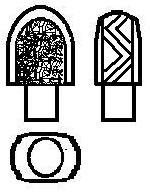This paper will describe and illustrate the many steps in the creation of the piece.
PHOTO 01: The main part of the Kachina Mask is turned out of blue Ferris File a Wax. The flat piece of wax is turned with steps in it.
Both pieces are turned in the manner described in my paper number 1. The thin section will have a hole left by the mounting screw.
The crown will be wax welded to the lower piece.
The upper portion of the assembly will be too thick. The inside of the top of the lower body is ground away. Some of the crown is also ground away.
PHOTO 02: The photo shows the flat piece welded to the main portion to the Kachina Mask.
Note that when two pieces of Ferris File a Wax are welded together each piece must be melted into each other. Ferris wax will not stick together unless the pieces are melted into each other. The steps in the flat disc may be seen in this photo.
onde
PHOTO 03: The next step is to carve the mouth portion of the Kachina Mask. A hole is drilled as shown and the mouth piece is carved so that a portion of it fits into the hole.
PHOTO 04: The mouth piece is engraved.
PHOTO 05: The mouth piece is wax welded to the main piece from the inside.
PHOTO 06: The design is engraved on the surface of the main piece.
The enraving procedure is described in paper
PHOTO 07: A thick block of wax is carved in the shape of the Horns. The horn shape is drawn on a piece of paper and is bonded to the wax with rubber cement. The wax can be carved with a large burr in a cable driven hand piece.
PHOTO 08: Once the horn is shaped it is split into two horns.
PHOTO 09: The horns are rounded off. Note the horns have to be off set in opposite directions.
PHOTO 10: The surface of the horns is texture with the tool shown. The tool is dragged across the wax perpendicular to the curve of the horns.
PHOTO 11: Two small discs are turned and textured.
note the hole in the top of the assembly. Without the hole, air would be trapped in the assemble when the investment is poured. There would be a large amount of silver in the area where the air was trapped.
PHOTO 12: The horns and the discs are wax welded to the main body of the Kachina mask.
PHOTO 13: Soft sprue wax is built up in the joint of the mouth and body and the discs and the body. The wax is poked with a hot tool to give the impression of fluffy feathers.


PHOTO 14: Feathers are cut from a sheet of 16 gage wax. The feathers are textured with a wire brush.
The white wire brush can be seen in the photo on the left. The quill of the feathers is built up with a hot tool.
Feathers are added to the back of the body of the mask. Pink 8, guage wax wire sprues are added to the body as shown above. The project is over sprued to insure the item will not be lost in casting. Assembly is vacuum cast following the casting instructions in my paper number 6.
The procedure described in paper no 2 is followed to prevent fire scale.
This is what the casting looks like after the investment if removed with a brass brush.
























No comments:
Post a Comment